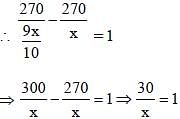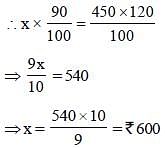SSC CGL Previous Year Questions: Profit & Loss - 5 - SSC CGL MCQ
23 Questions MCQ Test - SSC CGL Previous Year Questions: Profit & Loss - 5
A reduction of 20% in the price of sugar enables me to purchase 5 kg more for ₹ 600. Find the price of sugar per kg before reduction of price. (SSC CGL 1st Sit. 2011)
20% loss on selling price is what per cent loss on the cost price? (SSC CGL 1st Sit. 2011)
| 1 Crore+ students have signed up on EduRev. Have you? Download the App |
X sells two articles for ₹ 4,000 each with no loss and no gain in the interaction. If one was sold at a gain of 25% the other is sold at a loss of (SSC CGL 1st Sit. 2011)
If the price of sugar is raised by 25%, find by how much percent a householder must reduce his consumption of sugar so as not to increase his expenditure? (SSC CGL 1st Sit. 2011)
When the price of sugar decreases by 10%, a man could buy 1 kg more for ₹ 270. Then the original price of sugar per kg is (SSC CGL 1st Sit. 2011)
The cost price of an article is 40% of the selling price. What percent of the cost price is the selling price? (SSC CGL 1st Sit. 2011)
A trader bought two horses for ₹19,500. He sold one at a loss of 20% and the other at a profit of 15%. If the selling price of each horse is the same, then their cost prices are respectively. (SSC CGL 1st Sit. 2011)
Krishna purchased a number of articles at ₹10 for each and the same number for ₹ 14 each. He mixed them together and sold them for ₹13 each. Then his gain or loss percent is (SSC CGL 1st Sit. 2011)
While selling a watch, a shopkeeper gives a discount of 5%. If he gives a discount of 6%, he earns ₹ 15 less as profit. What is the marked price of the watch? (SSC CGL 1st Sit. 2011)
If the selling price of 10 articles is equal to the cost price of 11 articles, then the gain percent is (SSC CGL 1st Sit. 2011)
What single discount is equivalent to two successive discounts of 20% and 15%? (SSC CGL 1st Sit. 2011)
A shopkeeper allows a discount of 10% to his customers and still gains. 20%. Find the marked price of the article which costs ₹ 450. (SSC CGL 1st Sit. 2011)
The price of an article was first increased by 10% and then again by 20%. If the last increased price be ₹ 33, the original price was (SSC CGL 2nd Sit. 2010)
Successive discounts of 10%, 20% and 30% is equivalent to a single discount of (SSC CGL 2nd Sit. 2010)
If on a marked price, the difference of selling prices with a discount of 30% and two successive discounts of 20% and 10% is ₹72, then the marked price (in rupees) is (SSC CGL 2nd Sit. 2010)
If an article is sold at 200% profit, then the ratio of its cost price to its selling price will be (SSC CGL 1st Sit. 2010)
If the cost price of 15 books is equal to the selling price of 20 books, the loss percent is (SSC CGL 1st Sit. 2010)
If there is a profit of 20% on the cost price of an article, the percentage of profit calculated on its selling price will be (SSC CGL 1st Sit. 2010)
By selling an article, a man makes a profit of 25% of its selling price. His profit percent is (SSC CGL 2nd Sit. 2010)
By selling a bicycle for ₹ 2,850, Aa shopkeeper gains 14%. If the profit is reduced to 8%, then the selling price will be (SSC CGL 2nd Sit. 2010)
A shopkeeper earns a profit of 12% on selling a book at 10% discount on the printed price. The ratio for the cost price and the printed price of the book is (SSC CGL 1st Sit. 2010)
A manufacturer marked an article at ₹50 and sold it allowing 20% discount. If his profit was 25% then the cost price of the article was (SSC CGL 1st Sit. 2010)
If the ratio of cost price and selling price of an article be as 10 : 11, the percentage of profit is (SSC CGL 1st Sit. 2010)











 = 8(1/3)
= 8(1/3)































